UNITED STATES
SECURITIES AND EXCHANGE COMMISSION
Washington, D.C. 20549
FORM N-CSR
CERTIFIED SHAREHOLDER REPORT OF REGISTERED
MANAGEMENT INVESTMENT COMPANIES
Investment Company Act File Number: 811-04119
| T. Rowe Price High Yield Fund, Inc. |
|
| (Exact name of registrant as specified in charter) |
| |
| 100 East Pratt Street, Baltimore, MD 21202 |
|
| (Address of principal executive offices) |
| |
| David Oestreicher |
| 100 East Pratt Street, Baltimore, MD 21202 |
|
| (Name and address of agent for service) |
Registrant’s telephone number, including area code: (410) 345-2000
Date of fiscal year end: May 31
Date of reporting period: May 31, 2017
Item 1. Report to Shareholders
| U.S. High Yield Fund | May 31, 2017 |
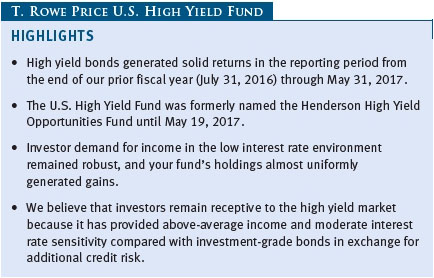
The views and opinions in this report were current as of May 31, 2017. They are not guarantees of performance or investment results and should not be taken as investment advice. Investment decisions reflect a variety of factors, and the managers reserve the right to change their views about individual stocks, sectors, and the markets at any time. As a result, the views expressed should not be relied upon as a forecast of the fund’s future investment intent. The report is certified under the Sarbanes-Oxley Act, which requires mutual funds and other public companies to affirm that, to the best of their knowledge, the information in their financial reports is fairly and accurately stated in all material respects.
REPORTS ON THE WEB
Sign up for our Email Program, and you can begin to receive updated fund reports and prospectuses online rather than through the mail. Log in to your account at troweprice.com for more information.
Manager’s Letter
Fellow Shareholders
I would like to welcome new investors to the T. Rowe Price U.S. High Yield Fund. As the portfolio manager of the strategy, I would like to briefly introduce myself and my team. I am returning to the T. Rowe Price fold where I was a high yield analyst and portfolio manager from 1996 to 2007. My team, which is based in Philadelphia, consists of four analysts and a trader. We have worked together for more than 10 years; have managed this fund since its inception on April 30, 2013; and, on average, have 18 years of industry experience.
This is our first shareholder report under the T. Rowe Price banner (the fund was formerly named the Henderson High Yield Opportunities Fund). Because our prior fiscal year ended on July 31, 2016, this annual report covers the 10-month period ended May 31, 2017. Going forward, we will publish semiannual reports for the six-month period ended November 30 and annual reports for 12 months through May 31.
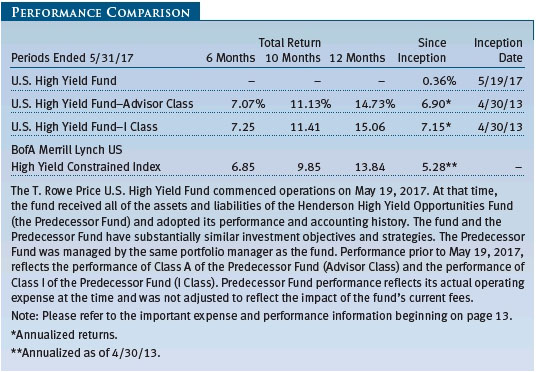
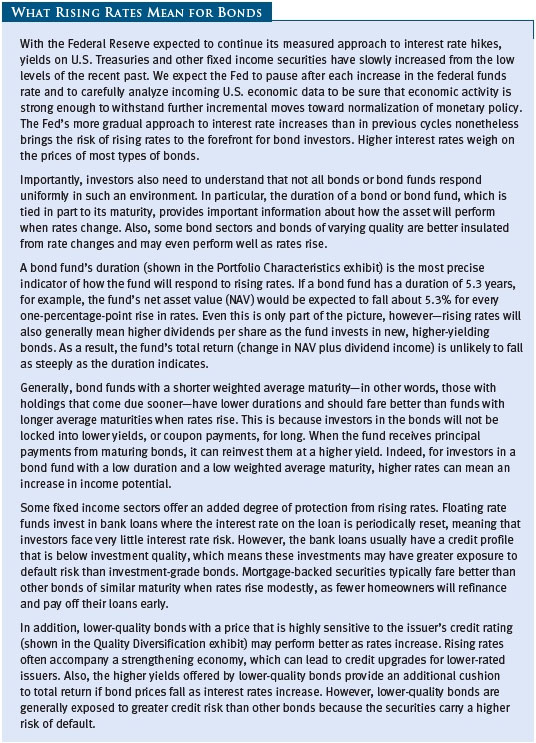
PORTFOLIO PERFORMANCE AND INVESTMENT PHILOSOPHY
The portfolio’s returns benefited from credit tier positioning as we were underweight BB and overweight CCC rated bonds versus the benchmark, the BoA Merrill Lynch US High Yield Concentrated Index, since the end of our prior fiscal year, ended July 31, 2016. Security selection within the CCC and B rated categories was particularly strong during the reporting period, and we emphasized owning higher-quality CCC rated credits. Your portfolio’s relative performance also benefited from our systematic move to add select credit risk and exposure to commodity-related segments throughout the year.
The strategy aims to generate alpha (excess return over the benchmark) through the different stages of credit cycles, and it has the flexibility to invest across the entire credit rating spectrum. While the fund primarily invests in below investment-grade, dollar-denominated bonds of U.S. companies, the strategy will also opportunistically invest in bank loans, convertible securities, and credit derivatives and in companies domiciled outside of the U.S.
The hallmarks of the fund’s investment strategy are concentration and conviction. Our disciplined investment process leads to consistency in research, analysis, and credit assessment to create a portfolio encompassing the team’s highest-conviction ideas, with exposure to 75–200 issuers (within our roughly 1,200-company high yield universe). We believe this issuer exposure range helps maintain an appropriate level of diversification, recognizing the unique liquidity challenges of the high yield bond market.
The team emphasizes proprietary, bottom-up credit research that enables us to formulate our own views on credit ratings and relative valuation. The idea generation process incorporates:
| ● | Weekly credit meetings and independent credit research |
| |
| ● | Market dynamics including pricing, liquidity, and issuance |
| |
| ● | Opportunities across the entire capital structure |
| |
| ● | Monthly performance and attribution review of the index universe |
| |
| ● | Meetings with company management, industry conferences, and market research |
While we incorporate some macro analysis, top-down decisions mostly occur at extreme parts of historic credit cycles. We also seek to add value through nimble and flexible trading in both the new issue and the secondary markets. The strategy seeks to capitalize on price inefficiencies that create attractive relative value opportunities across issuers due to size, credit quality, and geography. This philosophy affords the flexibility to access a range of bond issuers across each company’s entire capital structure. We believe that our disciplined security selection process will be the primary ingredient in alpha generation and long-term outperformance versus our benchmark and peer group.
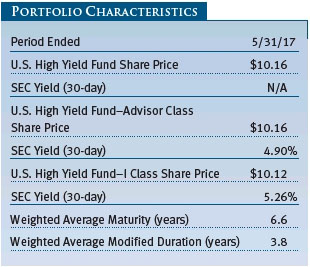
MARKET ENVIRONMENT
The U.S. high yield bond market gained 9.9% in the 10-month period from July 31, 2016, through May 31, 2017, outperforming most other global fixed income market sectors, including leveraged loans. U.S. high yield bonds outperformed leveraged loans (5.7%), five-year Treasuries (-2.1%), U.S. investment-grade corporates (0.6%), European high yield (6.9%), and emerging markets high yield (9.0%). The strength in the high yield market was largely due to the double-digit returns in stocks, light new issuance volume, and a general search for yield in a historically low global interest rate environment. Another source of strength over this period was the outsized performance of the commodity-related subsectors, namely energy and metals and mining—sectors that had been a significant drag on the U.S. high yield market in 2015 and early 2016.

Within the U.S. high yield market, BB and B rated bonds underperformed CCCs, and in several sectors the lower credit quality tiers vastly outperformed. The rebound in the energy sector that began in 2016 seemed to be losing momentum at the end of the period amid increased oil price volatility and less-compelling relative valuation. The energy sector now represents about 14% in the U.S high yield market versus more than 24% of the emerging markets high yield asset class and only 5% in European high yield.
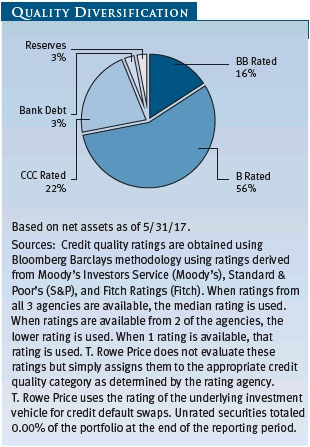
New issuance in our reporting period was moderate by historical standards at $25 to $30 billion per month. Only about 15% of issuance was used for acquisitions and leveraged buyout activity, while the bulk—approximately 60% of issuance—was directed at refinancing. New issue trends show that investors favor higher-rated issuance. Approximately 10% to 15% of new issue volume was from companies rated split B or CCC and was the lowest volume of lower-quality issuance since 2009.
The default rate for the asset class moderated over our reporting period. Defaults were concentrated in the energy and the metals and mining sectors. According to J.P. Morgan, the trailing 12-month default rate at the end of May was 1.3% (1.9% including distressed debt exchanges), and your fund did not own any bonds that defaulted. Overall, mutual fund flows into high yield were positive during 2016, but flows turned negative in 2017 as valuations became stretched and yields decreased.
PORTFOLIO REVIEW
In the 10-month period ended May 31, 2017, the basic industry, health care, and services sectors were the portfolio’s best relative performance contributors. Our weakest segments included technology, energy, and retail. The underperforming sectors in the benchmark during the period were retail, transportation, and consumer products. Our holdings that contributed the most to relative performance in the period were Sprint (wireless telecom), Intelsat (satellites), and Momentive (chemicals). Our worst relative performers were Pinnacle Operating (retail), Concordia (pharmaceuticals), and Cengage (media). (Please refer to the fund’s portfolio of investments for a complete list of holdings and the amount each represents in the portfolio.)
In aggregate, the fund’s security selection and sector and credit ratings allocation decisions were positive contributors. Our top 10 contributors generated 270 basis points (100 basis points equal 1.00%) of performance, while our bottom 10 detracted 101 basis points from performance. Your portfolio benefited from our gradual move to add credit risk and exposure to commodity-related segments.
At the end of the reporting period, the fund was positioned with slightly more credit risk than the benchmark, as measured by yield (plus 69 basis points) and credit spread (plus 74 basis points). (Credit spreads measure the yield difference between a Treasury bond and another similar-maturity security.) The portfolio’s credit quality positioning was generally more aggressive than the benchmark. We have systematically added to our exposure in the energy sector since the second quarter of 2016, decreasing our underweight allocation. Within the sector, we have focused on higher-quality exploration and production and midstream energy companies. Our energy outlook has improved given that oil has moved up to the $45 to $55 per barrel range; furthermore, most of the defaults and distressed exchanges that we expected to occur in the energy sector have mostly taken place.
We continue to be selective in the new issue market. We have made a conscious effort to add risk to the portfolio over the past year but have found it difficult given the challenging secondary market liquidity and the higher-quality bias of the new issue calendar.
OUTLOOK
We intend to keep the portfolio’s yield and credit spread slightly above the benchmark and, as always, to rely on credit selection as the main alpha generator. Low global government bond yields continue to drive strong demand for high yield bonds and floating rate loans on both the retail and institutional sides. We expect this trend to continue, although we are less excited about bank loans as valuations appear to be stretched. We expect the prospects for trade tariffs, changes in the tax-deductibility of interest, and potentially lower corporate tax rates in the U.S. to have a muted impact on U.S. high yield issuers compared with investment-grade issuers.
Respectfully submitted,

Kevin Loome
Chairman of the fund’s Investment Advisory Committee
June 14, 2017
The committee chairman has day-to-day responsibility for managing the portfolio and executing the fund’s investment program.
RISKS OF BOND INVESTING
Bonds are subject to interest rate risk, the decline in bond prices that usually accompanies a rise in interest rates, and credit risk, the chance that any fund holding could have its credit rating downgraded or that a bond issuer will default (fail to make timely payments of interest or principal), potentially reducing the fund’s income level and share price. High yield corporate bonds could have greater price declines than funds that invest primarily in high-quality bonds. Companies issuing high yield bonds are not as strong financially as those with higher credit ratings, so the bonds are usually considered speculative investments.
RISK MANAGEMENT: A KEY COMPONENT OF OUR STRATEGY
We would like to remind shareholders about some fundamental changes that have occurred in the fixed income markets in recent years. The markets have been particularly volatile over the past 12 months. The volatility has highlighted the importance of sound risk management.
Bond fund assets have grown substantially over the past three decades, with much of the growth taking place since 2008. This has been beneficial in many ways, but like many positive events, it has side effects as well. The prospect of rising interest rates triggers concerns that some investors could change course and redeploy their assets into other financial markets. Net outflows during periods of rising rates are not new; indeed, such was the case in 1994 and 2000 when rates turned up. Because of this evolving environment, T. Rowe Price is taking steps to ensure that our funds function smoothly during transitional periods as the Fed implements policy changes that are likely to affect the direction of interest rates. These measures include assessing the liquidity of our portfolios, conducting stress tests that take various market scenarios under consideration, and taking other steps to ensure successful implementation of our investment strategy. We want to reassure our shareholders that we are aware of the changing market environment and are monitoring it closely.
GLOSSARY
Basis point: One one-hundredth of one percentage point, or 0.01%.
Duration: The average time (expressed in years) needed for an investor to receive the present value of the future cash flows on a fixed income investment. It is used to measure a bond’s or bond fund’s sensitivity to interest rate changes. For example, a fund with a three-year duration would fall about 3% in price in response to a one-percentage-point increase in interest rates, and vice versa. Modified duration provides a more accurate estimate of the fund’s price sensitivity based solely on changes in real interest rates.
Lipper averages: The averages of available mutual fund performance returns for specified time periods in categories defined by Lipper Inc.
SEC yield (30-day): A method of calculating a fund’s yield that assumes all portfolio securities are held until maturity. Yield will vary and is not guaranteed.
The BofA Merrill Lynch US High Yield Constrained Index: An index that tracks the performance of domestic below investment-grade corporate bonds.
Weighted average maturity: A measure of a fund’s interest rate sensitivity. In general, the longer the average maturity, the greater the fund’s sensitivity to interest rate changes. The weighted average maturity may take into account the interest rate readjustment dates for certain securities.
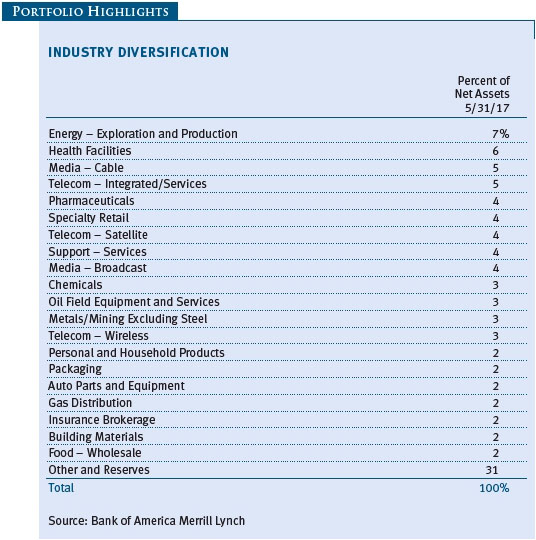
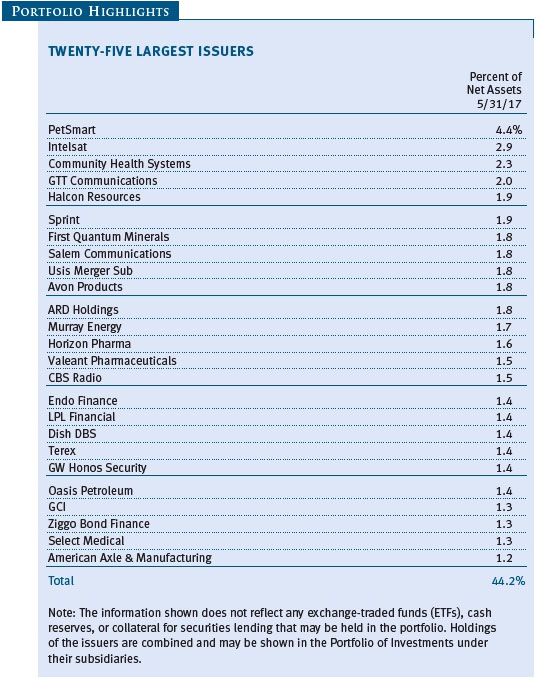
Performance and Expenses
As a mutual fund shareholder, you may incur two types of costs: (1) transaction costs, such as redemption fees or sales loads, and (2) ongoing costs, including management fees, distribution and service (12b-1) fees, and other fund expenses. The following example is intended to help you understand your ongoing costs (in dollars) of investing in the fund and to compare these costs with the ongoing costs of investing in other mutual funds. The example is based on an investment of $1,000 invested at the beginning of the most recent six-month period and held for the entire period.
Please note that the fund has three share classes: The original share class (Investor Class) charges no distribution and service (12b-1) fee, the Advisor Class shares are offered only through unaffiliated brokers and other financial intermediaries and charge a 0.25% 12b-1 fee, and I Class shares are available to institutionally oriented clients and impose no 12b-1 or administrative fee payment. Each share class is presented separately in the table.
Actual Expenses
The first line of the following table (Actual) provides information about actual account values and expenses based on the fund’s actual returns. You may use the information on this line, together with your account balance, to estimate the expenses that you paid over the period. Simply divide your account value by $1,000 (for example, an $8,600 account value divided by $1,000 = 8.6), then multiply the result by the number on the first line under the heading “Expenses Paid During Period” to estimate the expenses you paid on your account during this period.
Hypothetical Example for Comparison Purposes
The information on the second line of the table (Hypothetical) is based on hypothetical account values and expenses derived from the fund’s actual expense ratio and an assumed 5% per year rate of return before expenses (not the fund’s actual return). You may compare the ongoing costs of investing in the fund with other funds by contrasting this 5% hypothetical example and the 5% hypothetical examples that appear in the shareholder reports of the other funds. The hypothetical account values and expenses may not be used to estimate the actual ending account balance or expenses you paid for the period.
Note: T. Rowe Price charges an annual account service fee of $20, generally for accounts with less than $10,000. The fee is waived for any investor whose T. Rowe Price mutual fund accounts total $50,000 or more; accounts electing to receive electronic delivery of account statements, transaction confirmations, prospectuses, and shareholder reports; or accounts of an investor who is a T. Rowe Price Personal Services or Enhanced Personal Services client (enrollment in these programs generally requires T. Rowe Price assets of at least $250,000). This fee is not included in the accompanying table. If you are subject to the fee, keep it in mind when you are estimating the ongoing expenses of investing in the fund and when comparing the expenses of this fund with other funds.
You should also be aware that the expenses shown in the table highlight only your ongoing costs and do not reflect any transaction costs, such as redemption fees or sales loads. Therefore, the second line of the table is useful in comparing ongoing costs only and will not help you determine the relative total costs of owning different funds. To the extent a fund charges transaction costs, however, the total cost of owning that fund is higher.
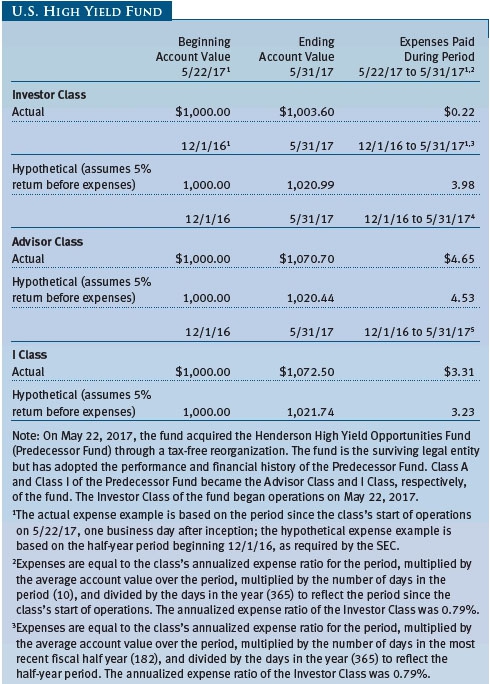
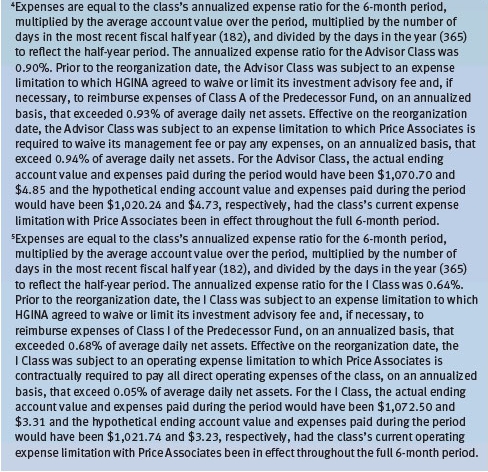
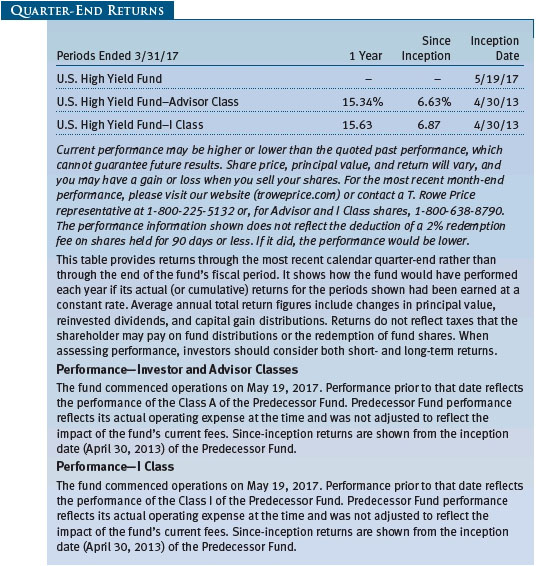

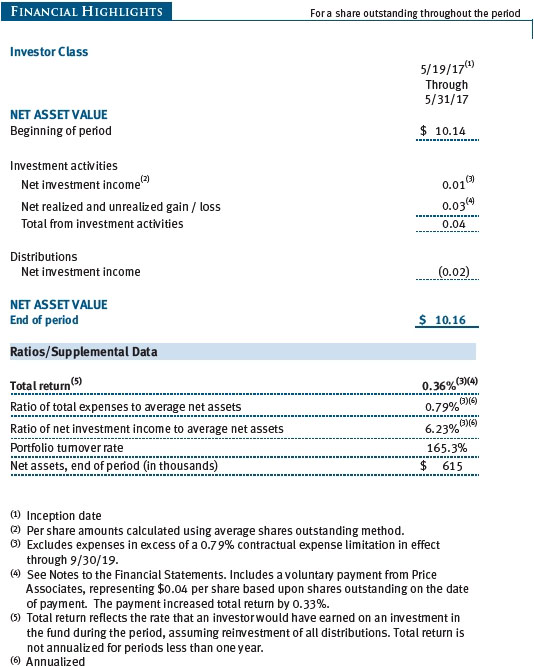
The accompanying notes are an integral part of these financial statements.
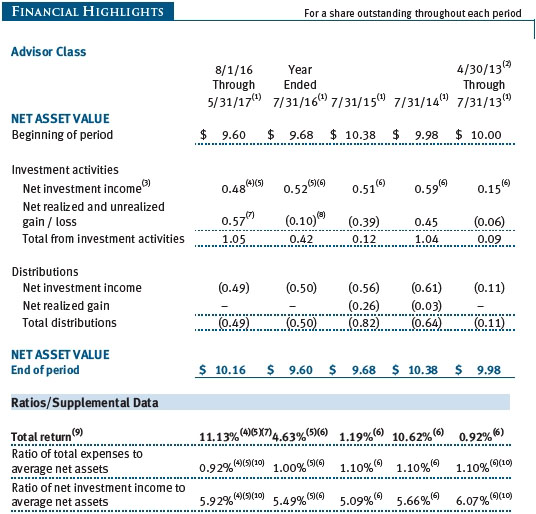
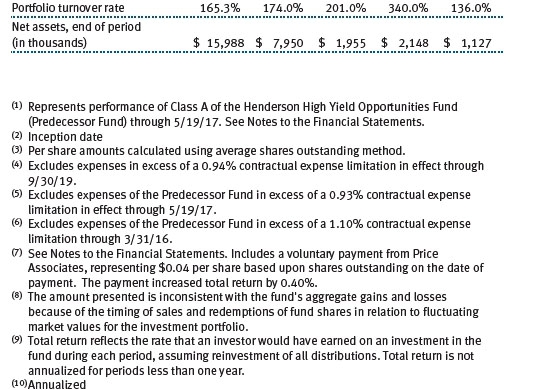
The accompanying notes are an integral part of these financial statements.
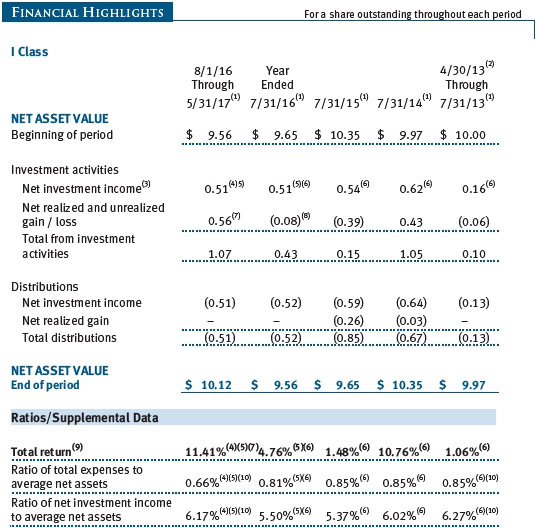
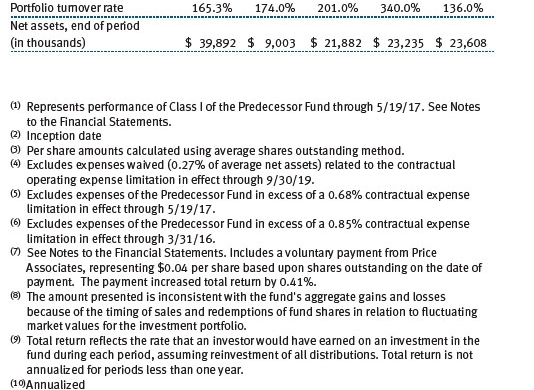
The accompanying notes are an integral part of these financial statements.
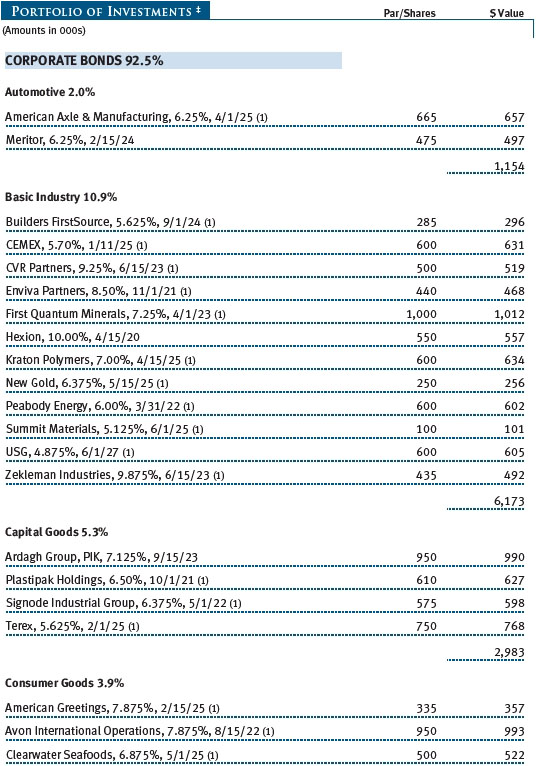
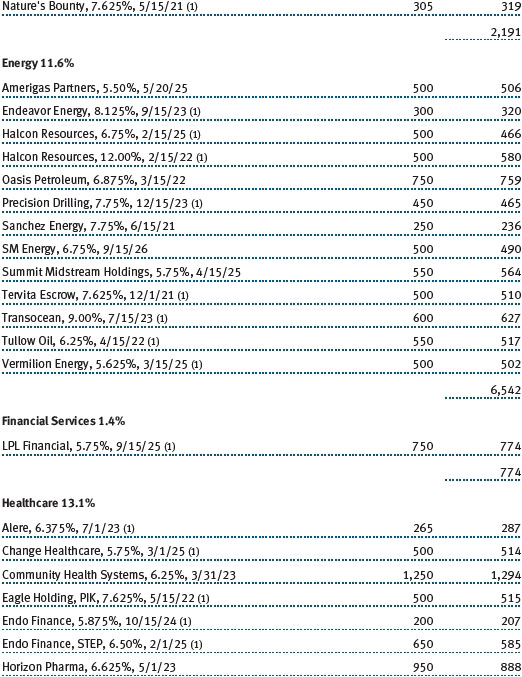
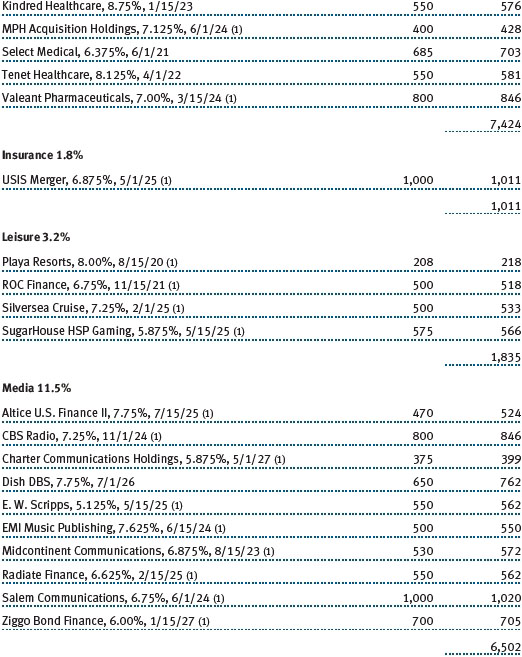
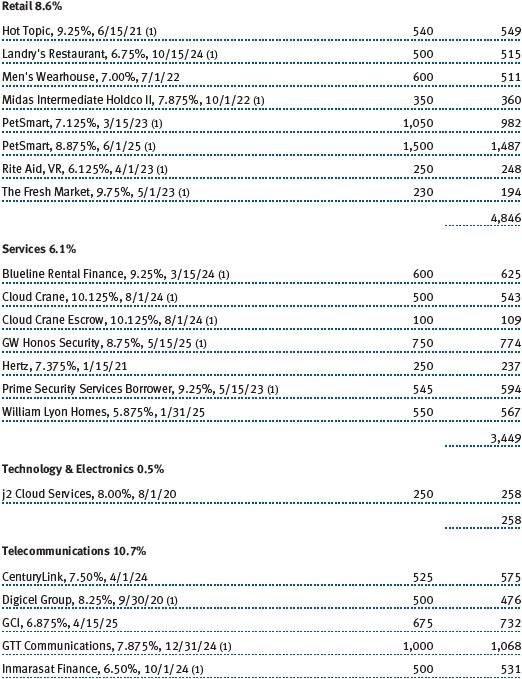


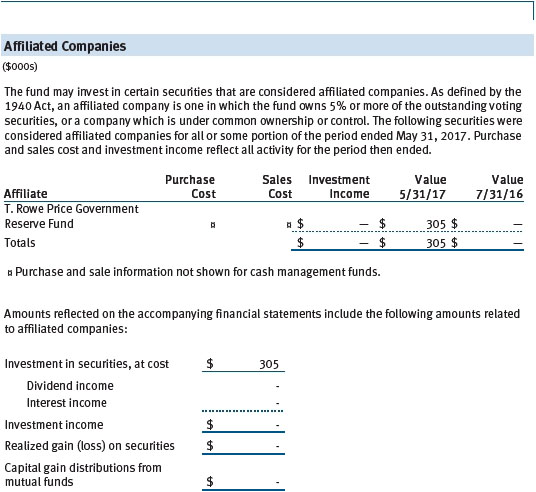
The accompanying notes are an integral part of these financial statements.
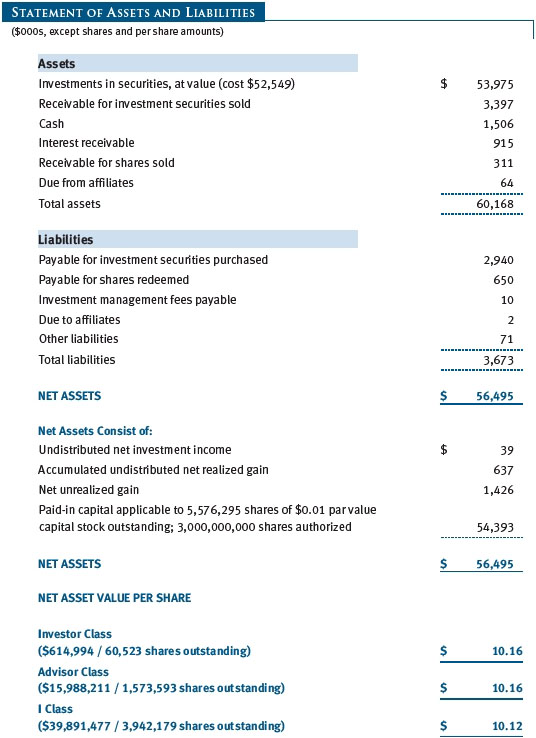
The accompanying notes are an integral part of these financial statements.
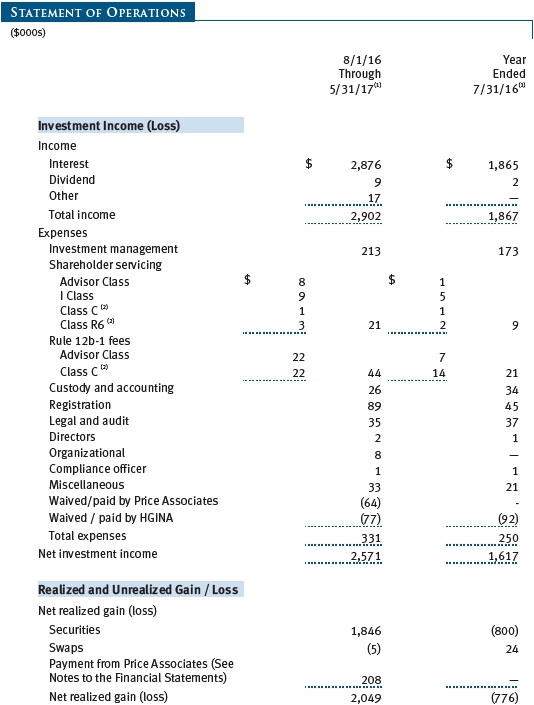
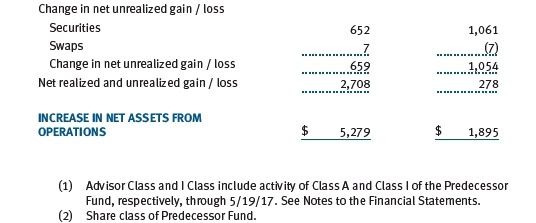
The accompanying notes are an integral part of these financial statements.
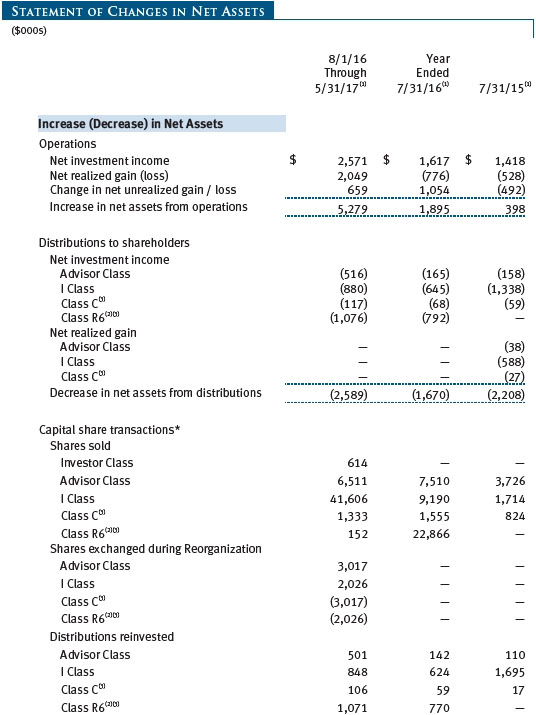
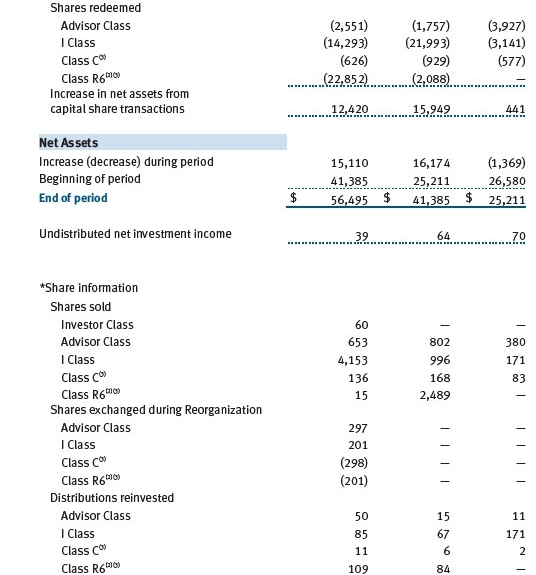
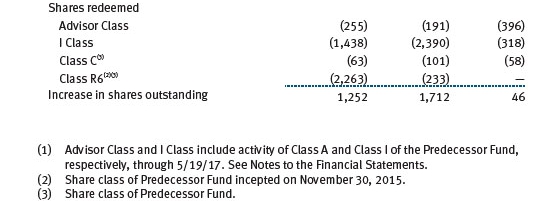
The accompanying notes are an integral part of these financial statements.
| Notes to Financial Statements |
T. Rowe Price High Yield Fund, Inc. (the corporation), is registered under the Investment Company Act of 1940 (the 1940 Act). The T. Rowe Price U.S. High Yield Fund (the fund or the Acquiring Fund) is a diversified, open-end management investment company established by the corporation, and incepted on May 19, 2017. The fund seeks total return, and secondarily, current income. The fund has three classes of shares: the U.S. High Yield Fund (Investor Class), the U.S High Yield Fund–Advisor Class (Advisor Class), and the U.S. High Yield Fund–I Class (I Class). Advisor Class shares are sold only through unaffiliated brokers and other unaffiliated financial intermediaries. I Class shares generally are available only to investors meeting a $1,000,000 minimum investment or certain other criteria. The Advisor Class operates under a Board-approved Rule 12b-1 plan pursuant to which the class compensates financial intermediaries for distribution, shareholder servicing, and/or certain administrative services; the Investor and I Classes do not pay Rule 12b-1 fees. Each class has exclusive voting rights on matters related solely to that class; separate voting rights on matters that relate to all classes; and, in all other respects, the same rights and obligations as the other classes.
On May 22, 2017 (the Reorganization Date), the Acquiring Fund, a newly organized series with no investment operations prior to the Reorganization Date, acquired all of the assets of the Henderson High Yield Opportunities Fund (the Predecessor Fund) in exchange for shares of the Acquiring Fund and assumption by the Acquiring Fund of substantially all of the Predecessor Fund’s liabilities. The exchange was accomplished as a tax-free reorganization (the Reorganization) in accordance with the Amended Agreement and Plan of Reorganization (the Reorganization Agreement), which was approved by the shareholders of the Predecessor Fund on May 15, 2017. Under the Reorganization, all outstanding shares of the Predecessor Fund were exchanged for shares of the Acquiring Fund. The exchange was based on values of the Predecessor Fund as of the close of business on the immediately preceding business day, May 19, 2017 (the Valuation Date). The Acquiring Fund has substantially similar investment objectives, principal investment strategies, and risks as the Predecessor Fund, and the portfolio management team of the Predecessor Fund has transitioned to the Acquiring Fund.
On May 22, 2017, Price Associates made a voluntary payment to the Acquiring Fund of $207,710 (the payment) to fully reimburse the fund for the effect of differences in valuation techniques between the Acquiring Fund and the Predecessor Fund. The payment from Price Associates was received in cash on May 23, 2017. The payment increased total return for the period ended May 31, 2017, by 0.33%, 0.40%, and 0.41% for the Investor Class, Advisor Class, and I Class, respectively.
The Acquiring Fund is the surviving legal entity, but has adopted the performance and financial history of the Predecessor Fund, which is included in these financial statements. Class A and Class I of the Predecessor Fund became the Advisor Class and I Class, respectively, of the Acquiring Fund. In addition, Class C shareholders of the Predecessor Fund received Advisor Class shares of the Acquiring Fund and Class R6 shareholders of the Predecessor Fund received I Class shares of the Acquiring Fund. After inclusion of the payment from Price Associates, the value of shares received was equal in value to the shares of the respective class of the Predecessor Fund on the Valuation Date.
The following is a summary of the shares issued to Class C and Class R6 of the Predecessor Fund in the Reorganization:

Because the Acquiring Fund was a newly organized series with no investment operations prior to the Reorganization Date, it is not practicable to present pro forma results of operations of the combined entity for the entire period ended May 31, 2017 as though the acquisition had occurred as of the beginning of the period (rather than on the actual Reorganization Date) or separate the amounts of revenue and earnings of the Predecessor Fund that have been included in the Acquiring Fund’s accompanying Statement of Operations since the Reorganization Date.
NOTE 1 - SIGNIFICANT ACCOUNTING POLICIES
Basis of Preparation The fund is an investment company and follows accounting and reporting guidance in the Financial Accounting Standards Board (FASB) Accounting Standards Codification Topic 946 (ASC 946). The accompanying financial statements were prepared in accordance with accounting principles generally accepted in the United States of America (GAAP), including, but not limited to, ASC 946. GAAP requires the use of estimates made by management. Management believes that estimates and valuations are appropriate; however, actual results may differ from those estimates, and the valuations reflected in the accompanying financial statements may differ from the value ultimately realized upon sale or maturity. Certain prior year amounts have been reclassified to conform to the current year presentation. A short-period annual report for the 10-month period from August 1, 2016 through May 31, 2017 is presented, reflecting the change from the Predecessor Fund’s fiscal year-end of July 31 to the Acquiring Fund’s fiscal year of May 31.
Investment Transactions, Investment Income, and Distributions Income and expenses are recorded on the accrual basis. Premiums and discounts on debt securities are amortized for financial reporting purposes. Dividends received from mutual fund investments are reflected as dividend income; capital gain distributions are reflected as realized gain/loss. Dividend income and capital gain distributions are recorded on the ex-dividend date. Income tax-related interest and penalties, if incurred, would be recorded as income tax expense. Investment transactions are accounted for on the trade date. Realized gains and losses are reported on the identified cost basis. Income distributions are declared by each class daily and paid monthly. Prior to the Reorganization, income distributions of the Predecessor Fund were declared and paid monthly. Distributions to shareholders are recorded on the ex-dividend date. Capital gain distributions are generally declared and paid by the fund annually.
Currency Translation Assets, including investments, and liabilities denominated in foreign currencies are translated into U.S. dollar values each day at the prevailing exchange rate, using the mean of the bid and asked prices of such currencies against U.S. dollars as quoted by a major bank. Purchases and sales of securities, income, and expenses are translated into U.S. dollars at the prevailing exchange rate on the date of the transaction. The effect of changes in foreign currency exchange rates on realized and unrealized security gains and losses is reflected as a component of security gains and losses.
Class Accounting Shareholder servicing, prospectus, and shareholder report expenses incurred by each class are charged directly to the class to which they relate. Expenses common to all classes and investment income are allocated to the classes based upon the relative daily net assets of each class’s settled shares; realized and unrealized gains and losses are allocated based upon the relative daily net assets of each class’s outstanding shares. The Advisor Class pays Rule 12b-1 fees, in an amount not exceeding 0.25% of the class’s average daily net assets.
Prior to the Reorganization, Class A and Class C of the Predecessor Fund operated under a Board-approved Rule 12b-1 plan pursuant to which the classes compensated financial intermediaries for distribution services. Under the distribution plan, the Predecessor Fund paid the distributor an annual fee of 0.25% and 1.00% of the average daily net assets attributable to its Class A shares and Class C shares, respectively.
Redemption Fees A 2.00% fee is assessed on redemptions of fund shares held for 90 days or less to deter short-term trading and to protect the interests of long-term shareholders. However, all shares of the fund received in connection with the Reorganization will not be subject to the redemption fee. Any fund shares purchased after the Reorganization and any shares exchanged from the fund to another fund that charges a redemption fee will be subject to the redemption fee, if applicable, upon redemption. Redemption fees are withheld from proceeds that shareholders receive from the sale or exchange of fund shares. The fees are paid to the fund and are recorded as an increase to paid-in capital. The fees may cause the redemption price per share to differ from the net asset value per share.
New Accounting Guidance In October 2016, the Securities and Exchange Commission (SEC) issued a new rule, Investment Company Reporting Modernization, which, among other provisions, amends Regulation S-X to require standardized, enhanced disclosures, particularly related to derivatives, in investment company financial statements. Compliance with the guidance is effective for financial statements related to periods ending on or after August 1, 2017; adoption will have no effect on the fund’s net assets or results of operations.
NOTE 2 - VALUATION
The fund’s financial instruments are valued and each class’s net asset value (NAV) per share is computed at the close of the New York Stock Exchange (NYSE), normally 4 p.m. ET, each day the NYSE is open for business. However, the NAV per share may be calculated at a time other than the normal close of the NYSE if trading on the NYSE is restricted, if the NYSE closes earlier, or as may be permitted by the SEC.
Fair Value The fund’s financial instruments are reported at fair value, which GAAP defines as the price that would be received to sell an asset or paid to transfer a liability in an orderly transaction between market participants at the measurement date. The T. Rowe Price Valuation Committee (the Valuation Committee) is an internal committee that has been delegated certain responsibilities by the fund’s Board of Directors (the Board) to ensure that financial instruments are appropriately priced at fair value in accordance with GAAP and the 1940 Act. Subject to oversight by the Board, the Valuation Committee develops and oversees pricing-related policies and procedures and approves all fair value determinations. Specifically, the Valuation Committee establishes procedures to value securities; determines pricing techniques, sources, and persons eligible to effect fair value pricing actions; oversees the selection, services, and performance of pricing vendors; oversees valuation-related business continuity practices; and provides guidance on internal controls and valuation-related matters. The Valuation Committee reports to the Board and has representation from legal, portfolio management and trading, operations, risk management, and the fund’s treasurer.
Various valuation techniques and inputs are used to determine the fair value of financial instruments. GAAP establishes the following fair value hierarchy that categorizes the inputs used to measure fair value:
Level 1 – quoted prices (unadjusted) in active markets for identical financial instruments that the fund can access at the reporting date
Level 2 – inputs other than Level 1 quoted prices that are observable, either directly or indirectly (including, but not limited to, quoted prices for similar financial instruments in active markets, quoted prices for identical or similar financial instruments in inactive markets, interest rates and yield curves, implied volatilities, and credit spreads)
Level 3 – unobservable inputs
Observable inputs are developed using market data, such as publicly available information about actual events or transactions, and reflect the assumptions that market participants would use to price the financial instrument. Unobservable inputs are those for which market data are not available and are developed using the best information available about the assumptions that market participants would use to price the financial instrument. GAAP requires valuation techniques to maximize the use of relevant observable inputs and minimize the use of unobservable inputs. When multiple inputs are used to derive fair value, the financial instrument is assigned to the level within the fair value hierarchy based on the lowest-level input that is significant to the fair value of the financial instrument. Input levels are not necessarily an indication of the risk or liquidity associated with financial instruments at that level but rather the degree of judgment used in determining those values.
Valuation Techniques Debt securities generally are traded in the over-the-counter (OTC) market. Securities with remaining maturities of one year or more at the time of acquisition are valued at prices furnished by dealers who make markets in such securities or by an independent pricing service, which considers the yield or price of bonds of comparable quality, coupon, maturity, and type, as well as prices quoted by dealers who make markets in such securities. Securities with remaining maturities of less than one year at the time of acquisition generally use amortized cost in local currency to approximate fair value. However, if amortized cost is deemed not to reflect fair value or the fund holds a significant amount of such securities with remaining maturities of more than 60 days, the securities are valued at prices furnished by dealers who make markets in such securities or by an independent pricing service. Generally, debt securities are categorized in Level 2 of the fair value hierarchy; however, to the extent the valuations include significant unobservable inputs, the securities would be categorized in Level 3.
Investments in mutual funds are valued at the mutual fund’s closing NAV per share on the day of valuation and are categorized in Level 1 of the fair value hierarchy. Assets and liabilities other than financial instruments, including short-term receivables and payables, are carried at cost, or estimated realizable value, if less, which approximates fair value.
Thinly traded financial instruments and those for which the above valuation procedures are inappropriate or are deemed not to reflect fair value are stated at fair value as determined in good faith by the Valuation Committee. The objective of any fair value pricing determination is to arrive at a price that could reasonably be expected from a current sale. Financial instruments fair valued by the Valuation Committee are primarily private placements, restricted securities, warrants, rights, and other securities that are not publicly traded.
Subject to oversight by the Board, the Valuation Committee regularly makes good faith judgments to establish and adjust the fair valuations of certain securities as events occur and circumstances warrant. For instance, in determining the fair value of troubled or thinly traded debt instruments, the Valuation Committee considers a variety of factors, which may include, but are not limited to, the issuer’s business prospects, its financial standing and performance, recent investment transactions in the issuer, strategic events affecting the company, market liquidity for the issuer, and general economic conditions and events. In consultation with the investment and pricing teams, the Valuation Committee will determine an appropriate valuation technique based on available information, which may include both observable and unobservable inputs. The Valuation Committee typically will afford greatest weight to actual prices in arm’s length transactions, to the extent they represent orderly transactions between market participants, transaction information can be reliably obtained, and prices are deemed representative of fair value. However, the Valuation Committee may also consider other valuation methods such as a discount or premium from market value of a similar, freely traded security of the same issuer; discounted cash flows; yield to maturity; or some combination. Fair value determinations are reviewed on a regular basis and updated as information becomes available, including actual purchase and sale transactions of the issue. Because any fair value determination involves a significant amount of judgment, there is a degree of subjectivity inherent in such pricing decisions, and fair value prices determined by the Valuation Committee could differ from those of other market participants. Depending on the relative significance of unobservable inputs, including the valuation technique(s) used, fair valued securities may be categorized in Level 2 or 3 of the fair value hierarchy.
Valuation Inputs The following table summarizes the fund’s financial instruments, based on the inputs used to determine their fair values on May 31, 2017:
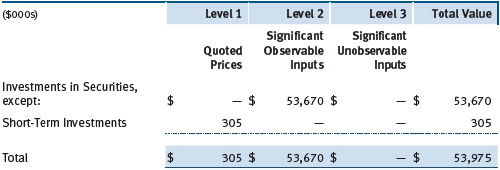
There were no material transfers between Levels 1 and 2 during the period ended May 31, 2017.
NOTE 3 - DERIVATIVE INSTRUMENTS
During the period ended May 31, 2017, the fund invested in derivative instruments. As defined by GAAP, a derivative is a financial instrument whose value is derived from an underlying security price, foreign exchange rate, interest rate, index of prices or rates, or other variable; it requires little or no initial investment and permits or requires net settlement. The fund invests in derivatives only if the expected risks and rewards are consistent with its investment objectives, policies, and overall risk profile, as described in its prospectus and Statement of Additional Information. The fund may use derivatives for a variety of purposes, such as seeking to hedge against declines in principal value, increase yield, invest in an asset with greater efficiency and at a lower cost than is possible through direct investment, or to adjust portfolio duration and credit exposure. The risks associated with the use of derivatives are different from, and potentially much greater than, the risks associated with investing directly in the instruments on which the derivatives are based. The fund at all times maintains sufficient cash reserves, liquid assets, or other SEC-permitted asset types to cover its settlement obligations under open derivative contracts.
The fund values its derivatives at fair value and recognizes changes in fair value currently in its results of operations. Accordingly, the fund does not follow hedge accounting, even for derivatives employed as economic hedges. Generally, the fund accounts for its derivatives on a gross basis. It does not offset the fair value of derivative liabilities against the fair value of derivative assets on its financial statements, nor does it offset the fair value of derivative instruments against the right to reclaim or obligation to return collateral. As of May 31, 2017, the fund held no derivative instruments.
Additionally, during the period ended May 31, 2017, the fund recognized $5,000 of realized loss on Swaps and a $7,000 change in unrealized gain/loss on Swaps related to its investments in credit derivatives; such amounts are included on the accompanying Statement of Operations. During the year ended July 31, 2016, the fund recognized $24,000 of realized gain on Swaps and a $(7,000) change in unrealized gain/loss on Swaps related to its investments in credit derivatives.
Swaps The fund is subject to credit risk in the normal course of pursuing its investment objectives and uses swap contracts to help manage such risk. The fund may use swaps in an effort to manage exposure to changes in interest rates, inflation rates, and credit quality; to adjust overall exposure to certain markets; to enhance total return or protect the value of portfolio securities; to serve as a cash management tool; or to adjust portfolio duration and credit exposure. Swap agreements can be settled either directly with the counterparty (bilateral swap) or through a central clearinghouse (centrally cleared swap). Fluctuations in the fair value of a contract are reflected in unrealized gain or loss and are reclassified to realized gain or loss upon contract termination or cash settlement. Net periodic receipts or payments required by a contract increase or decrease, respectively, the value of the contract until the contractual payment date, at which time such amounts are reclassified from unrealized to realized gain or loss. For bilateral swaps, cash payments are made or received by the fund on a periodic basis in accordance with contract terms; unrealized gain on contracts and premiums paid are reflected as assets and unrealized loss on contracts and premiums received are reflected as liabilities on the accompanying Statement of Assets and Liabilities. For bilateral swaps, premiums paid or received are amortized over the life of the swap and are recognized as realized gain or loss in the Statement of Operations. For centrally cleared swaps, payments are made or received by the fund each day to settle the daily fluctuation in the value of the contract (variation margin). Accordingly, the value of a centrally cleared swap included in net assets is the unsettled variation margin; net variation margin receivable is reflected as an asset and net variation margin payable is reflected as a liability on the accompanying Statement of Assets and Liabilities.
Credit default swaps are agreements where one party (the protection buyer) agrees to make periodic payments to another party (the protection seller) in exchange for protection against specified credit events, such as certain defaults and bankruptcies related to an underlying credit instrument, or issuer or index of such instruments. Upon occurrence of a specified credit event, the protection seller is required to pay the buyer the difference between the notional amount of the swap and the value of the underlying credit, either in the form of a net cash settlement or by paying the gross notional amount and accepting delivery of the relevant underlying credit. For credit default swaps where the underlying credit is an index, a specified credit event may affect all or individual underlying securities included in the index and will be settled based upon the relative weighting of the affected underlying security(ies) within the index. Risks related to the use of credit default swaps include the possible inability of the fund to accurately assess the current and future creditworthiness of underlying issuers, the possible failure of a counterparty to perform in accordance with the terms of the swap agreements, potential government regulation that could adversely affect the fund’s swap investments, and potential losses in excess of the fund’s initial investment.
During the period ended May 31, 2017, the volume of the fund’s activity in swaps, based on underlying notional amounts, was generally less than 1% of net assets.
NOTE 4 - OTHER INVESTMENT TRANSACTIONS
Consistent with its investment objective, the fund engages in the following practices to manage exposure to certain risks and/or to enhance performance. The investment objective, policies, program, and risk factors of the fund are described more fully in the fund’s prospectus and Statement of Additional Information.
Noninvestment-Grade Debt At May 31, 2017, approximately 53% of the fund’s net assets were invested, either directly or through its investment in T. Rowe Price institutional funds, in noninvestment-grade debt, including “high yield” or “junk” bonds or leveraged loans. The noninvestment-grade debt market may experience sudden and sharp price swings due to a variety of factors, including changes in economic forecasts, stock market activity, large sustained sales by major investors, a high-profile default, or a change in market sentiment. These events may decrease the ability of issuers to make principal and interest payments and adversely affect the liquidity or value, or both, of such securities. Investments in noninvestment-grade holdings may be considered speculative.
Restricted Securities The fund may invest in securities that are subject to legal or contractual restrictions on resale. Prompt sale of such securities at an acceptable price may be difficult and may involve substantial delays and additional costs.
Bank Loans The fund may invest in bank loans, which represent an interest in amounts owed by a borrower to a syndicate of lenders. Bank loans are generally noninvestment grade and often involve borrowers whose financial condition is highly leveraged. Bank loans may be in the form of either assignments or participations. A loan assignment transfers all legal, beneficial, and economic rights to the buyer, and transfer typically requires consent of both the borrower and agent. In contrast, a loan participation generally entitles the buyer to receive the cash flows from principal, interest, and any fee payments on a portion of a loan; however, the seller continues to hold legal title to that portion of the loan. As a result, the buyer of a loan participation generally has no direct recourse against the borrower and is exposed to credit risk of both the borrower and seller of the participation. Bank loans often have extended settlement periods, usually may be repaid at any time at the option of the borrower, and may require additional principal to be funded at the borrowers’ discretion at a later date (unfunded commitments). Until settlement, the fund maintains liquid assets sufficient to settle its unfunded loan commitments. The fund reflects both the funded portion of a bank loan as well as its unfunded commitment in the Portfolio of Investments. However, if a credit agreement provides no initial funding of a tranche, and funding of the full commitment at a future date(s) is at the borrower’s discretion and considered uncertain, a loan is reflected in the Portfolio of Investments only if, and only to the extent that, the fund has actually settled a funding commitment.
Other Purchases and sales of portfolio securities other than short-term securities aggregated $145,699,000 and $80,036,000, respectively, for the period ended May 31, 2017.
NOTE 5 - FEDERAL INCOME TAXES
No provision for federal income taxes is required since the fund intends to continue to qualify as a regulated investment company under Subchapter M of the Internal Revenue Code and distribute to shareholders all of its taxable income and gains. Distributions determined in accordance with federal income tax regulations may differ in amount or character from net investment income and realized gains for financial reporting purposes. Financial reporting records are adjusted for permanent book/tax differences to reflect tax character but are not adjusted for temporary differences.
The fund files U.S. federal, state, and local tax returns as required. The fund’s tax returns are subject to examination by the relevant tax authorities until expiration of the applicable statute of limitations, which is generally three years after the filing of the tax return but which can be extended to six years in certain circumstances. Tax returns for open years have incorporated no uncertain tax positions that require a provision for income taxes.
Reclassifications between income and gain relate primarily to the character of premium payments and unrealized gains and losses on swaps. For the period ended May 31, 2017, the following reclassifications were recorded to reflect tax character (there was no impact on results of operations or net assets):

Distributions during the period ended May 31, 2017, year ended July 31, 2016, and year ended July 31, 2015, totaled $2,589,000, $1,670,000, and $2,208,000, respectively, and were characterized as ordinary income for tax purposes. At May 31, 2017, the tax-basis cost of investments and components of net assets were as follows:
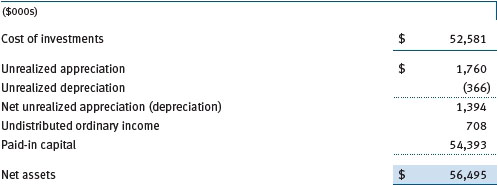
During the period ended May 31, 2017, the fund utilized $1,383,000 of capital loss carryforwards.
NOTE 6 - RELATED PARTY TRANSACTIONS
The fund is managed by T. Rowe Price Associates, Inc. (Price Associates), a wholly owned subsidiary of T. Rowe Price Group, Inc. (Price Group). The investment management agreement between the fund and Price Associates provides for an annual investment management fee, which is computed daily and paid monthly. The fee consists of an individual fund fee, equal to 0.30% of the fund’s average daily net assets, and a group fee. The group fee rate is calculated based on the combined net assets of certain mutual funds sponsored by Price Associates (the group) applied to a graduated fee schedule, with rates ranging from 0.48% for the first $1 billion of assets to 0.265% for assets in excess of $650 billion. The fund’s group fee is determined by applying the group fee rate to the fund’s average daily net assets. At May 31, 2017, the effective annual group fee rate was 0.29%.
Prior to the Reorganization, pursuant to a separate investment advisory agreement, Henderson Global Investors (North America) Inc. (HGINA) served as investment advisor to the Predecessor Fund and earned a fee for such services based on 0.50% of average daily net assets of the Predecessor Fund.
The Investor Class and Advisor Class are each subject to a contractual expense limitation through the limitation dates indicated in the table below. During the limitation period, Price Associates is required to waive its management fee or pay any expenses (excluding interest, expenses related to borrowings, taxes, brokerage, and other non-recurring expenses permitted by the investment management agreement) that would otherwise cause the class’s ratio of annualized total expenses to average net assets (expense ratio) to exceed its expense limitation. Each class is required to repay Price Associates for expenses previously waived/paid to the extent the class’s net assets grow or expenses decline sufficiently to allow repayment without causing the class’s expense ratio to exceed its expense limitation in effect at the time of the waiver. However, no repayment will be made more than three years after the date of a payment or waiver.

The I Class is also subject to an operating expense limitation (I Class limit) pursuant to which Price Associates is contractually required to pay all operating expenses of the I Class, excluding management fees, interest, expenses related to borrowings, taxes, brokerage, and other non-recurring expenses permitted by the investment management agreement, to the extent such operating expenses, on an annualized basis, exceed 0.05% of average net assets. This agreement will continue until September 30, 2019, and may be renewed, revised, or revoked only with approval of the fund’s Board. The I Class is required to repay Price Associates for expenses previously paid to the extent the class’s net assets grow or expenses decline sufficiently to allow repayment without causing the class’s operating expenses to exceed the I Class limit in effect at the time of the waiver. However, no repayment will be made more than three years after the date of a payment or waiver.
Pursuant to these agreements with Price Associates, $64,000 of expenses were waived/paid by Price Associates during the period May 22, 2017 through May 31, 2017 and remain subject to repayment by the fund. Certain costs associated with the Reorganization that do not have continuing benefit to the Fund in the amount of $37,000 were expensed immediately following the Reorganization and reimbursed by Price Associates. These amounts are not subject to reimbursement by the Fund.
Prior to the Reorganization, pursuant to a separate contractual expense limitation agreement, HGINA agreed to waive or limit its investment advisory fee and, if necessary, to reimburse expenses of the Predecessor Fund in order to limit total annual ordinary operating expenses, including distribution and service fees, but excluding any acquired fund fees and expenses as a result of investing in other HGINA advised funds, as a percentage of average daily net assets as follows:

Pursuant to this agreement, $77,000 and $92,000 of expenses were waived and/or reimbursed by HGINA during the period ended May 31, 2017 and year ended July 31, 2016, respectively.
Prior to the Reorganization, the Predecessor Fund bore the full compensation paid to the Chief Compliance Officer. This compensation, together with other compliance-related costs associated with the Predecessor Fund, is reflected as “Compliance officer expenses” in the Statement of Operations.
In addition, the fund has entered into service agreements with Price Associates and a wholly owned subsidiary of Price Associates (collectively, Price). Price Associates provides certain accounting and administrative services to the fund. T. Rowe Price Services, Inc. provides shareholder and administrative services in its capacity as the fund’s transfer and dividend-disbursing agent. For the period ended May 31, 2017, expenses incurred pursuant to these service agreements were $2,000 for Price Associates and less than $1,000 for T. Rowe Price Services, Inc. The total amount payable at period-end pursuant to these service agreements is reflected as Due to Affiliates in the accompanying financial statements.
The fund may invest in the T. Rowe Price Government Reserve Fund, the T. Rowe Price Treasury Reserve Fund, or the T. Rowe Price Short-Term Fund (collectively, the Price Reserve Funds), open-end management investment companies managed by Price Associates and considered affiliates of the fund. The Price Reserve Funds are offered as short-term investment options to mutual funds, trusts, and other accounts managed by Price Associates or its affiliates and are not available for direct purchase by members of the public. The Price Reserve Funds pay no investment management fees.
The fund may participate in securities purchase and sale transactions with other funds or accounts advised by Price Associates (cross trades), in accordance with procedures adopted by the fund’s Board and Securities and Exchange Commission rules, which require, among other things, that such purchase and sale cross trades be effected at the independent current market price of the security. During the period May 22, 2017 through May 31, 2017, the fund had no purchases or sales cross trades with other funds or accounts advised by Price Associates. Prior to the Reorganization, the Predecessor Fund had no purchase or sale transactions with other funds or accounts advised by HGINA during the period August 1, 2016 through May 19, 2017.
| Report of Independent Registered Public Accounting Firm |
To the Board of Directors of T. Rowe Price High Yield Fund, Inc. and
Shareholders of T. Rowe Price U.S. High Yield Fund
In our opinion, the accompanying statement of assets and liabilities, including the portfolio of investments, and the related statements of operations and of changes in net assets and the financial highlights present fairly, in all material respects, the financial position of the T. Rowe Price U.S. High Yield Fund (one of the portfolios comprising T. Rowe Price High Yield Fund, Inc., hereafter referred to as the “Fund”) as of May 31, 2017, and the results of its operations and the changes in its net assets for the period August 1, 2016 through May 31, 2017, and the financial highlights for the periods ended on May 31, 2017, in conformity with accounting principles generally accepted in the United States of America. These financial statements and financial highlights (hereafter referred to as “financial statements”) are the responsibility of the Fund’s management. Our responsibility is to express an opinion on these financial statements based on our audit. We conducted our audit of these financial statements in accordance with the standards of the Public Company Accounting Oversight Board (United States). Those standards require that we plan and perform the audit to obtain reasonable assurance about whether the financial statements are free of material misstatement. An audit includes examining, on a test basis, evidence supporting the amounts and disclosures in the financial statements, assessing the accounting principles used and significant estimates made by management, and evaluating the overall financial statement presentation. We believe that our audit, which included confirmation of securities as of May 31, 2017 by correspondence with the custodian, brokers, and transfer agent, provides a reasonable basis for our opinion. The financial statements of the Henderson High Yield Opportunities Fund (the “Predecessor Fund”) as of and for the year ended July 31, 2016 and the financial highlights for the four years ended on or prior to July 31, 2016, (not presented herein other than the statement of operations for the year ended July 31, 2016, the statements of changes in net assets for each of the two years ended July 31, 2016 and the financial highlights for each of the four years ended on or prior to July 31, 2016) were audited by other auditors whose report dated September 23, 2016, expressed an unqualified opinion on those statements.
PricewaterhouseCoopers LLP
Baltimore, Maryland
July 19, 2017
| Information on Proxy Voting Policies, Procedures, and Records |
A description of the policies and procedures used by T. Rowe Price funds and portfolios to determine how to vote proxies relating to portfolio securities is available in each fund’s Statement of Additional Information. You may request this document by calling 1-800-225-5132 or by accessing the SEC’s website, sec.gov.
The description of our proxy voting policies and procedures is also available on our corporate website. To access it, please visit the following Web page:
https://www3.troweprice.com/usis/corporate/en/utility/policies.html
Scroll down to the section near the bottom of the page that says, “Proxy Voting Policies.” Click on the Proxy Voting Policies link in the shaded box.
Each fund’s most recent annual proxy voting record is available on our website and through the SEC’s website. To access it through T. Rowe Price, visit the website location shown above, and scroll down to the section near the bottom of the page that says, “Proxy Voting Records.” Click on the Proxy Voting Records link in the shaded box.
| How to Obtain Quarterly Portfolio Holdings |
The fund files a complete schedule of portfolio holdings with the Securities and Exchange Commission for the first and third quarters of each fiscal year on Form N-Q. The fund’s Form N-Q is available electronically on the SEC’s website (sec.gov); hard copies may be reviewed and copied at the SEC’s Public Reference Room, 100 F St. N.E., Washington, DC 20549. For more information on the Public Reference Room, call 1-800-SEC-0330.
| Approval of Investment Management Agreement |
At an in-person meeting held on February 6, 2017 (Meeting), the fund’s Board of Directors (Board), including a majority of the fund’s independent directors, approved the initial investment management agreement (Advisory Contract) between the fund and its investment advisor, T. Rowe Price Associates, Inc. (Advisor). At the Meeting, the Board considered the factors and reached the conclusions described below relating to the selection of the Advisor and the approval of the Advisory Contract. The independent directors were assisted in their evaluation of the Advisory Contract by independent legal counsel from whom they received separate legal advice.
In considering and approving the Advisory Contract, the Board considered the information it believed was relevant, including, but not limited to, the information discussed below. The Board considered not only the specific information presented in connection with the Meeting but also the knowledge gained over time through interaction with the Advisor about various topics. The Board meets regularly and, at each of its meetings, covers an extensive agenda of topics and materials and considers factors that are relevant to its annual consideration of the renewal of the T. Rowe Price funds’ advisory contracts, including performance and the services and support provided to the funds and their shareholders.
At the Meeting, the Board considered that the fund was being established as a shell fund to acquire the assets of the Henderson High Yield Opportunities Fund (Acquired Fund) as part of a tax-free reorganization. At the time of the Meeting, it was expected that, on May 22, 2017, the reorganization would be consummated if already approved by the Acquired Fund’s shareholders, and the fund would adopt the Acquired Fund’s performance and accounting history. After the reorganization, the fund would be opened to the public for investment.
Services Provided by the Advisor
The Board considered the nature, quality, and extent of the services that were expected to be provided to the fund by the Advisor. These anticipated services included, but were not limited to, directing the fund’s investments in accordance with its investment program and the overall management of the fund’s portfolio, as well as a variety of related activities such as financial, investment operations, and administrative services; compliance; maintaining the fund’s records and registrations; and shareholder communications. The Board noted that the fund’s portfolio management team would become employees of the Advisor prior to the reorganization and would be located in an office separate from other investment personnel of the Advisor. The Board also reviewed the background and experience of the Advisor’s senior management team and investment personnel involved in the management of the fund, as well as the Advisor’s compliance record. The Board concluded that it was satisfied with the nature, quality, and extent of the services expected to be provided by the Advisor.
Investment Performance of the Fund
The Board reviewed the Acquired Fund’s performance for the one-year, three-year, and since-inception periods as of December 31, 2016, as well as the Acquired Fund’s calendar year returns for 2014, 2015, and 2016. Based in part on the Acquired Fund’s performance, the Board concluded that it was reasonable to approve the establishment of the fund and the fund’s acquisition of the Acquired Fund.
Costs, Benefits, Profits, and Economies of Scale
The Board considered whether the fund will benefit under the fee levels set forth in the Advisory Contract from any economies of scale realized by the Advisor. Under the Advisory Contract, the fund would pay a fee to the Advisor for investment management services composed of two components—a group fee rate based on the combined average net assets of most of the T. Rowe Price funds (including the fund) that declines at certain asset levels and an individual fund fee rate based on the fund’s average daily net assets—and the fund would pay its own expenses of operations (subject to expense limitations agreed to by the Advisor with respect to the fund’s Investor Class, Advisor Class, and I Class). The Board concluded that the advisory fee structure for the fund is expected to provide for a reasonable sharing of benefits from any economies of scale with the fund’s investors.
Fees and Expenses
The Board was provided with information regarding industry trends in management fees and expenses. The Board reviewed comparisons of the fund’s proposed fee structure relative to similarly managed competitor funds and T. Rowe Price funds. On the basis of the information provided and the factors considered, the Board concluded that the fees to be paid by the fund were reasonable and approved the initial Advisory Contract for the fund.
Approval of the Advisory Contract
As noted, the Board approved the initial Advisory Contract. No single factor was considered in isolation or to be determinative to the decision. Rather, the Board concluded, in light of a weighting and balancing of all factors considered, that it was in the best interests of the fund and its future shareholders for the Board to approve the Advisory Contract (including the fees to be charged for services thereunder).
| About the Fund’s Directors and Officers |
Your fund is overseen by a Board of Directors (Board) that meets regularly to review a wide variety of matters affecting or potentially affecting the fund, including performance, investment programs, compliance matters, advisory fees and expenses, service providers, and business and regulatory affairs. The Board elects the fund’s officers, who are listed in the final table. At least 75% of the Board’s members are independent of T. Rowe Price Associates, Inc. (T. Rowe Price), and its affiliates; “inside” or “interested” directors are employees or officers of T. Rowe Price. The business address of each director and officer is 100 East Pratt Street, Baltimore, Maryland 21202. The Statement of Additional Information includes additional information about the fund directors and is available without charge by calling a T. Rowe Price representative at 1-800-638-5660.
| Independent Directors | | |
| |
| Name | | |
| (Year of Birth) | | |
| Year Elected* | | |
| [Number of T. Rowe Price | | Principal Occupation(s) and Directorships of Public Companies and |
| Portfolios Overseen] | | Other Investment Companies During the Past Five Years |
| | | |
| Anthony W. Deering | | Chairman, Exeter Capital, LLC, a private investment firm (2004 to |
| (1945) | | present); Director and Advisory Board Member, Deutsche Bank |
| 1984 | | North America (2004 to present); Director, Vornado Real Estate |
| [189] | | Investment Trust (2004 to 2012); Director, Under Armour (2008 |
| | to present); Director, Brixmor Real Estate Investment Trust (2012 |
| | to present) |
| | | |
| Bruce W. Duncan | | Chief Executive Officer and Director (2009 to December 2016), |
| (1951) | | Chairman of the Board (January 2016 to present), and President |
| 2013 | | (2009 to September 2016), First Industrial Realty Trust, an owner |
| [189] | | and operator of industrial properties; Chairman of the Board |
| | (2005 to September 2016) and Director (1999 to September |
| | 2016), Starwood Hotels & Resorts, a hotel and leisure company; |
| | Director, Boston Properties (May 2016 to present); Director, Marriott |
| | International, Inc. (September 2016 to present) |
| | | |
| Robert J. Gerrard, Jr. | | Advisory Board Member, Pipeline Crisis/Winning Strategies, a |
| (1952) | | collaborative working to improve opportunities for young African |
| 2013 | | Americans (1997 to present) |
| [189] | | |
| | | |
| Paul F. McBride | | Advisory Board Member, Vizzia Technologies (2015 to present) |
| (1956) | | |
| 2013 | | |
| [189] | | |
| | | |
| Cecilia E. Rouse, Ph.D. | | Dean, Woodrow Wilson School (2012 to present); Professor and |
| (1963) | | Researcher, Princeton University (1992 to present); Member of |
| 2013 | | National Academy of Education (2010 to present); Director, MDRC, |
| [189] | | a nonprofit education and social policy research organization |
| | (2011 to present); Research Associate of Labor Studies Program |
| | (2011 to 2015) and Board Member (2015 to present), National |
| | Bureau of Economic Research (2011 to present); Chair of Committee |
| | on the Status of Minority Groups in the Economic Profession |
| | (2012 to present); Vice President (2015 to present), American |
| | Economic Association |
| | | |
| John G. Schreiber | | Owner/President, Centaur Capital Partners, Inc., a real estate |
| (1946) | | investment company (1991 to present); Cofounder, Partner, and |
| 1992 | | Cochairman of the Investment Committee, Blackstone Real Estate |
| [189] | | Advisors, L.P. (1992 to 2015); Director, General Growth Properties, |
| | Inc. (2010 to 2013); Director, Blackstone Mortgage Trust, a real |
| | estate finance company (2012 to 2016); Director and Chairman of |
| | the Board, Brixmor Property Group, Inc. (2013 to present); Director, |
| | Hilton Worldwide (2013 to present); Director, Hudson Pacific |
| | Properties (2014 to 2016) |
| | | |
| Mark R. Tercek | | President and Chief Executive Officer, The Nature Conservancy |
| (1957) | | (2008 to present) |
| 2009 | | |
| [189] | | |
| |
| *Each independent director serves until retirement, resignation, or election of a successor. |
| |
| Inside Directors | | |
| |
| Name | | |
| (Year of Birth) | | |
| Year Elected* | | |
| [Number of T. Rowe Price | | Principal Occupation(s) and Directorships of Public Companies and |
| Portfolios Overseen] | | Other Investment Companies During the Past Five Years |
| | | |
| Edward C. Bernard | | Director and Vice President, T. Rowe Price; Vice Chairman of the |
| (1956) | | Board, Director, and Vice President, T. Rowe Price Group, Inc.; |
| 2006 | | Chairman of the Board, Director, and Vice President, T. Rowe Price |
| [189] | | Investment Services, Inc., and T. Rowe Price Services, Inc.; Chairman |
| | of the Board and Director, T. Rowe Price Retirement Plan Services, |
| | Inc.; Chairman of the Board, Chief Executive Officer, Director, and |
| | President, T. Rowe Price International and T. Rowe Price Trust |
| | Company; Chairman of the Board, all funds |
| | | |
| Edward A. Wiese, CFA | | Vice President, T. Rowe Price, T. Rowe Price Group, Inc., T. Rowe |
| (1959) | | Price International, and T. Rowe Price Trust Company; President, |
| 2015 | | High Yield Fund |
| [57] | | |
| |
| *Each inside director serves until retirement, resignation, or election of a successor. |
| Officers | | |
| |
| Name (Year of Birth) | | |
| Position Held With High Yield Fund | | Principal Occupation(s) |
| | | |
| Jason A. Bauer (1979) | | Vice President, T. Rowe Price and T. Rowe Price |
| Vice President | | Group, Inc. |
| | | |
| Darrell N. Braman (1963) | | Vice President, Price Hong Kong, Price |
| Vice President and Secretary | | Singapore, T. Rowe Price, T. Rowe Price Group, |
| | Inc., T. Rowe Price International, T. Rowe Price |
| | Investment Services, Inc., and T. Rowe Price |
| | Services, Inc. |
| | | |
| Andrew M. Brooks (1956) | | Vice President, T. Rowe Price and T. Rowe Price |
| Vice President | | Group, Inc. |
| | | |
| Charles Devereux (1969) | | Vice President, T. Rowe Price; formerly, high |
| Vice President | | yield analyst, Henderson Global Investors |
| | (to 2017) |
| | | |
| Michael F. Connelly, CFA (1977) | | Vice President, T. Rowe Price and T. Rowe Price |
| Vice President | | Group, Inc. |
| | | |
| Michael Della Vedova (1969) | | Vice President, T. Rowe Price Group, Inc., and |
| Vice President | | T. Rowe Price International |
| | | |
| Carson R. Dickson, CFA, CPA (1976) | | Vice President, T. Rowe Price and T. Rowe Price |
| Vice President | | Group, Inc. |
| | | |
| Devon Everhart (1977) | | Vice President, T. Rowe Price; formerly, high |
| Vice President | | yield analyst, Henderson Global Investors |
| | (to 2017) |
| | | |
| Matthew Fanandakis (1983) | | Vice President, T. Rowe Price; formerly, high |
| Vice President | | yield analyst, Henderson Global Investors |
| | (to 2017) |
| | | |
| Stephen M. Finamore, CPA (1976) | | Vice President, T. Rowe Price and T. Rowe Price |
| Vice President | | Group, Inc. |
| | | |
| Justin T. Gerbereux, CFA (1975) | | Vice President, T. Rowe Price, T. Rowe Price |
| Vice President | | Group, Inc., and T. Rowe Price Trust Company |
| | | |
| John R. Gilner (1961) | | Chief Compliance Officer and Vice President, |
| Chief Compliance Officer | | T. Rowe Price; Vice President, T. Rowe Price |
| | Group, Inc., and T. Rowe Price Investment |
| | Services, Inc. |
| | | |
| Gregg Gola (1965) | | Vice President, T. Rowe Price; formerly, high |
| Vice President | | yield trader, Henderson Global Investors |
| | (to 2017) |
| | | |
| Andrew P. Jamison (1981) | | Vice President, T. Rowe Price and T. Rowe Price |
| Vice President | | Group, Inc. |
| | | |
| Paul J. Krug, CPA (1964) | | Vice President, T. Rowe Price, T. Rowe Price |
| Vice President | | Group, Inc., and T. Rowe Price Trust Company |
| | | |
| Kevin P. Loome, CFA (1967) | | Vice President, T. Rowe Price and T. Rowe |
| Vice President | | Price Group, Inc.; formerly, Head of U.S. Credit, |
| | Henderson Global Investors (to 2017) and Head |
| | of High Yield and Bank Loans, Delaware |
| | Investments (to 2013) |
| | | |
| Paul M. Massaro, CFA (1975) | | Vice President, T. Rowe Price, T. Rowe Price |
| Vice President | | Group, Inc., and T. Rowe Price Trust Company |
| | | |
| Catherine D. Mathews (1963) | | Vice President, T. Rowe Price, T. Rowe Price |
| Treasurer and Vice President | | Group, Inc., and T. Rowe Price Trust Company |
| | | |
| David Oestreicher (1967) | | Director, Vice President, and Secretary, T. Rowe |
| Vice President | | Price Investment Services, Inc., T. Rowe Price |
| | Retirement Plan Services, Inc., T. Rowe |
| | Price Services, Inc., and T. Rowe Price Trust |
| | Company; Chief Legal Officer, Vice President, |
| | and Secretary, T. Rowe Price Group, Inc.; Vice |
| | President and Secretary, T. Rowe Price and |
| | T. Rowe Price International; Vice President, |
| | Price Hong Kong and Price Singapore |
| | | |
| John W. Ratzesberger (1975) | | Vice President, T. Rowe Price, T. Rowe Price |
| Vice President | | Group, Inc., and T. Rowe Price Trust Company; |
| | formerly, North American Head of Listed |
| | Derivatives Operation, Morgan Stanley (to 2013) |
| | | |
| Shannon H. Rauser (1987) | | Employee, T. Rowe Price |
| Assistant Secretary | | |
| | | |
| Brian A. Rubin, CPA (1974) | | Vice President, T. Rowe Price, T. Rowe Price |
| Vice President | | Group, Inc., and T. Rowe Price Trust Company |
| | | |
| Deborah D. Seidel (1962) | | Vice President, T. Rowe Price, T. Rowe Price |
| Vice President | | Group, Inc., T. Rowe Price Investment Services, |
| | Inc., and T. Rowe Price Services, Inc. |
| | | |
| Jamie Shin, CFA (1984) | | Vice President, T. Rowe Price and T. Rowe Price |
| Vice President | | Group, Inc. |
| | | |
| Michael J. Trivino (1981) | | Vice President, T. Rowe Price and T. Rowe Price |
| Vice President | | Group, Inc. |
| | | |
| Mark J. Vaselkiv (1958) | | Vice President, T. Rowe Price, T. Rowe Price |
| Executive Vice President | | Group, Inc., and T. Rowe Price Trust Company |
| | | |
| Thea N. Williams (1961) | | Vice President, T. Rowe Price, T. Rowe Price |
| Vice President | | Group, Inc., and T. Rowe Price Trust Company |
| | | |
| Douglas Zinser (1975) | | Vice President, T. Rowe Price; formerly, high |
| Vice President | | yield analyst, Henderson Global Investors |
| | (to 2017) |
| |
| Unless otherwise noted, officers have been employees of T. Rowe Price or T. Rowe Price International for at least 5 years. |
Item 2. Code of Ethics.
The registrant has adopted a code of ethics, as defined in Item 2 of Form N-CSR, applicable to its principal executive officer, principal financial officer, principal accounting officer or controller, or persons performing similar functions. A copy of this code of ethics is filed as an exhibit to this Form N-CSR. No substantive amendments were approved or waivers were granted to this code of ethics during the period covered by this report.
Item 3. Audit Committee Financial Expert.
The registrant’s Board of Directors/Trustees has determined that Mr. Bruce W. Duncan qualifies as an audit committee financial expert, as defined in Item 3 of Form N-CSR. Mr. Duncan is considered independent for purposes of Item 3 of Form N-CSR.
Item 4. Principal Accountant Fees and Services.
(a) – (d) Aggregate fees billed for the last two fiscal years for professional services rendered to, or on behalf of, the registrant by the registrant’s principal accountant were as follows:

Audit fees include amounts related to the audit of the registrant’s annual financial statements and services normally provided by the accountant in connection with statutory and regulatory filings. Audit-related fees include amounts reasonably related to the performance of the audit of the registrant’s financial statements and specifically include the issuance of a report on internal controls and, if applicable, agreed-upon procedures related to fund acquisitions. Tax fees include amounts related to services for tax compliance, tax planning, and tax advice. The nature of these services specifically includes the review of distribution calculations and the preparation of Federal, state, and excise tax returns. All other fees include the registrant’s pro-rata share of amounts for agreed-upon procedures in conjunction with service contract approvals by the registrant’s Board of Directors/Trustees.
(e)(1) The registrant’s audit committee has adopted a policy whereby audit and non-audit services performed by the registrant’s principal accountant for the registrant, its investment adviser, and any entity controlling, controlled by, or under common control with the investment adviser that provides ongoing services to the registrant require pre-approval in advance at regularly scheduled audit committee meetings. If such a service is required between regularly scheduled audit committee meetings, pre-approval may be authorized by one audit committee member with ratification at the next scheduled audit committee meeting. Waiver of pre-approval for audit or non-audit services requiring fees of a de minimis amount is not permitted.
(2) No services included in (b) – (d) above were approved pursuant to paragraph (c)(7)(i)(C) of Rule 2-01 of Regulation S-X.
(f) Less than 50 percent of the hours expended on the principal accountant’s engagement to audit the registrant’s financial statements for the most recent fiscal year were attributed to work performed by persons other than the principal accountant’s full-time, permanent employees.
(g) The aggregate fees billed for the most recent fiscal year and the preceding fiscal year by the registrant’s principal accountant for non-audit services rendered to the registrant, its investment adviser, and any entity controlling, controlled by, or under common control with the investment adviser that provides ongoing services to the registrant were $1,765,000 and $2,409,000, respectively.
(h) All non-audit services rendered in (g) above were pre-approved by the registrant’s audit committee. Accordingly, these services were considered by the registrant’s audit committee in maintaining the principal accountant’s independence.
Item 5. Audit Committee of Listed Registrants.
Not applicable.
Item 6. Investments.
(a) Not applicable. The complete schedule of investments is included in Item 1 of this Form N-CSR.
(b) Not applicable.
Item 7. Disclosure of Proxy Voting Policies and Procedures for Closed-End Management Investment Companies.
Not applicable.
Item 8. Portfolio Managers of Closed-End Management Investment Companies.
Not applicable.
Item 9. Purchases of Equity Securities by Closed-End Management Investment Company and Affiliated Purchasers.
Not applicable.
Item 10. Submission of Matters to a Vote of Security Holders.
Not applicable.
Item 11. Controls and Procedures.
(a) The registrant’s principal executive officer and principal financial officer have evaluated the registrant’s disclosure controls and procedures within 90 days of this filing and have concluded that the registrant’s disclosure controls and procedures were effective, as of that date, in ensuring that information required to be disclosed by the registrant in this Form N-CSR was recorded, processed, summarized, and reported timely.
(b) The registrant’s principal executive officer and principal financial officer are aware of no change in the registrant’s internal control over financial reporting that occurred during the registrant’s second fiscal quarter covered by this report that has materially affected, or is reasonably likely to materially affect, the registrant’s internal control over financial reporting.
Item 12. Exhibits.
(a)(1) The registrant’s code of ethics pursuant to Item 2 of Form N-CSR is attached.
(2) Separate certifications by the registrant's principal executive officer and principal financial officer, pursuant to Section 302 of the Sarbanes-Oxley Act of 2002 and required by Rule 30a-2(a) under the Investment Company Act of 1940, are attached.
(3) Written solicitation to repurchase securities issued by closed-end companies: not applicable.
(b) A certification by the registrant's principal executive officer and principal financial officer, pursuant to Section 906 of the Sarbanes-Oxley Act of 2002 and required by Rule 30a-2(b) under the Investment Company Act of 1940, is attached.
SIGNATURES
Pursuant to the requirements of the Securities Exchange Act of 1934 and the Investment Company Act of 1940, the registrant has duly caused this report to be signed on its behalf by the undersigned, thereunto duly authorized.
T. Rowe Price High Yield Fund, Inc.
| By | | /s/ Edward C. Bernard |
| | | Edward C. Bernard |
| | | Principal Executive Officer |
| |
| Date | | July 18, 2017 | | | | |
Pursuant to the requirements of the Securities Exchange Act of 1934 and the Investment Company Act of 1940, this report has been signed below by the following persons on behalf of the registrant and in the capacities and on the dates indicated.
| By | | /s/ Edward C. Bernard |
| | | Edward C. Bernard |
| | | Principal Executive Officer |
| |
| Date | | July 18, 2017 | | | | |
| |
| |
| By | | /s/ Catherine D. Mathews |
| | | Catherine D. Mathews |
| | | Principal Financial Officer |
| |
| Date | | July 18, 2017 | | | | |






































